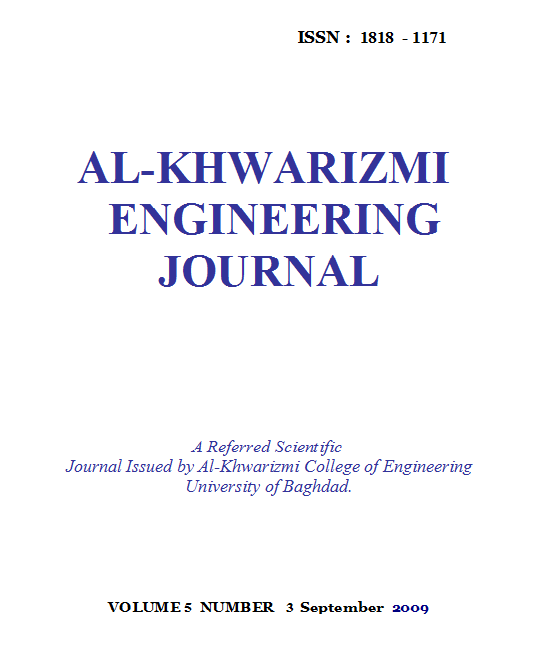The Investigation of Monitoring Systems for SMAW Processes
Abstract
The monitoring weld quality is increasingly important because great financial savings are possible because of it, and this especially happens in manufacturing where defective welds lead to losses in production and necessitate time consuming and expensive repair. This research deals with the monitoring and controllability of the fusion arc welding process using Artificial Neural Network (ANN) model. The effect of weld parameters on the weld quality was studied by implementing the experimental results obtained from welding a non-Galvanized steel plate ASTM BN 1323 of 6 mm thickness in different weld parameters (current, voltage, and travel speed) monitored by electronic systems that are followed by destructive (Tensile and Bending) and non-destructive (Hardness on HAZ) tests to investigate the quality control on the weld specimens. The experimental results obtained are then processed through the ANN model to control the welding process and predict the level of quality for different welding conditions. It has been deduced that the welding conditions (current, voltage, and travel speed) have a dominant factors that affect the weld quality and strength. Also we found that for certain welding condition, there was an optimum weld travel speed to obtain an optimum weld quality. The system supports quality control procedures and welding productivity without doing more periodic destructive mechanical test to dozens of samples.
Downloads
References
[2] C. S. WU, T. Polet & D. Rehfeldt, "A Fuzzy Logic System for Process Monitoring and Quality Evaluation in GMAW", 2001,Sponsored by the American Welding Society and the Welding Research Council. WELDING JOURNAL 33-s to 38-s.
[3] Hallowell Avenue Arcadia, "Weld Monitoring Primer for MicroResistance Welding – Update", 2005, MicroJoining Solutions – microTips™ 5563, CA 91007.
[4] Rittichai Phounium & Bovornchok Poopat, "On-line Quality Monitoring of Welding Defect Susceptibility in SMAW", 2001, by King Mongkut's University of technology Thonburi, Bankok.
[5] CHUN-HUA ZHANG, LI DI, ZENG AN, "Welding Quality Monitoring and Management System Based on Data Mining Technology", 2003, Proceedings of the Second International Conference on Machine Learning and Cybernetics 0-7803-7865-2/03/ 17.00 2003 IEEE, pp 13-17.
[6] A. G. Glover, J. T. McGrath, M. J. Tinkler & G. C. Weatherly, "The Influence of Cooling Rate and Composition on Weld Metal Microstructure in C-Mn & HSLA Steels", 1977, Welding Journal, pp. 267s - 273s.
[7] G. M. Evans, "Effect of Manganese on Microstructure and Properties of All Weld Metal Deposits", 1980, Welding Journal, pp. 67s - 75s.
[8] M. ZHOU, H. ZHANG, & S. J. HU., "Relationships between Quality and Attributes of Spot Welds", 2003, Sponsored by the American Welding Society and the Welding Research Council, Welding Journal, 72-s to 77-s.
[9] Sadek C.A. Alfaro, Diogo de S. Mendonca and Marcelo S. Matos, "Emission spectrometry evaluation in arc welding monitoring system"2006, Published by Elsevier Science Ltd. Journal of Materials Processing Technology, Vol. 179, (2006) pp. 219 – 224.
[10] Aimen Mohammed Ahmed Bachaa, "Wear Monitoring in Turning Processes using Vibration and Strain Measurements", 2005, Msc thesis - Mechanical Engineering – Baghdad University.
Downloads
Published
Issue
Section
License
Copyright: Open Access authors retain the copyrights of their papers, and all open access articles are distributed under the terms of the Creative Commons Attribution License, which permits unrestricted use, distribution, and reproduction in any medium, provided that the original work is properly cited. The use of general descriptive names, trade names, trademarks, and so forth in this publication, even if not specifically identified, does not imply that these names are not protected by the relevant laws and regulations. While the advice and information in this journal are believed to be true and accurate on the date of its going to press, neither the authors, the editors, nor the publisher can accept any legal responsibility for any errors or omissions that may be made. The publisher makes no warranty, express or implied, with respect to the material contained herein.












